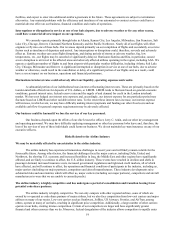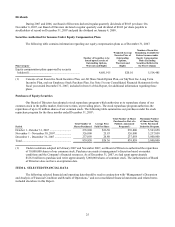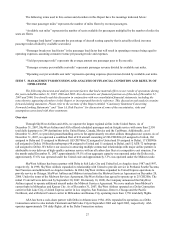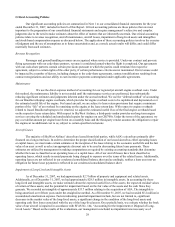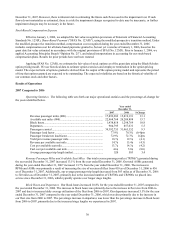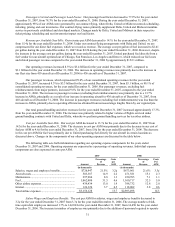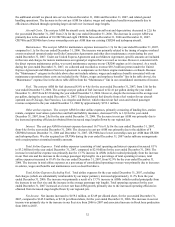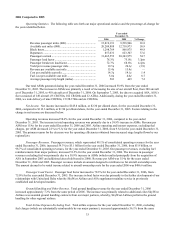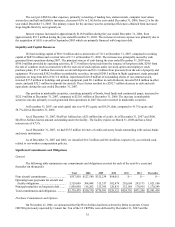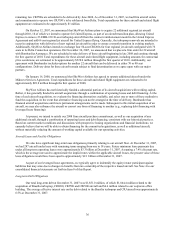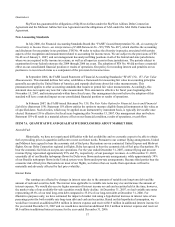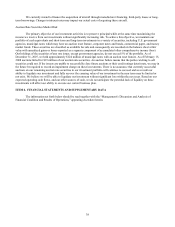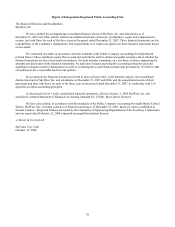SkyWest Airlines 2007 Annual Report Download - page 30
Download and view the complete annual report
Please find page 30 of the 2007 SkyWest Airlines annual report below. You can navigate through the pages in the report by either clicking on the pages listed below, or by using the keyword search tool below to find specific information within the annual report.29
Critical Accounting Policies
Our significant accounting policies are summarized in Note 1 to our consolidated financial statements for the year
ended December 31, 2007, included in Item 8 of this Report. Critical accounting policies are those policies that are most
important to the preparation of our consolidated financial statements and require management’ s subjective and complex
judgments due to the need to make estimates about the effect of matters that are inherently uncertain. Our critical accounting
policies relate to revenue recognition, aircraft maintenance, aircraft leases, impairment of long-lived assets and intangibles
and stock-based compensation expense as discussed below. The application of these accounting policies involves the exercise
of judgment and the use of assumptions as to future uncertainties and, as a result, actual results will differ, and could differ
materially from such estimates.
Revenue Recognition
Passenger and ground handling revenues are recognized when service is provided. Under our contract and pro-rate
flying agreements with our code-share partners, revenue is considered earned when the flight is completed. Our agreements
with our code-share partners contain certain provisions pursuant to which the parties could terminate the respective
agreement, subject to certain rights of the other party, if certain performance criteria are not maintained. Our revenues could
be impacted by a number of factors, including changes to the code-share agreements, contract modifications resulting from
contract renegotiations and our ability to earn incentive payments contemplated under applicable agreements.
Maintenance
We use the direct-expense method of accounting for our regional jet aircraft engine overhaul costs. Under
this method, the maintenance liability is not recorded until the maintenance services are performed, thus substantially
reducing significant estimates and judgments inherent under the accrual method. We use the “deferral method” of accounting
for our Brasilia turboprop engine overhauls, which provides for engine overhaul costs to be capitalized and depreciated over
the estimated useful life of the engine. For leased aircraft, we are subject to lease return provisions that require a minimum
portion of the “life” of an overhaul be remaining on the engine at the lease return date. With respect to engine overhauls
related to leased Brasilia turboprops to be returned, we adjust the estimated useful lives of the final engine overhauls based
on the respective lease return dates. With respect to SkyWest Airlines, a third-party vendor provides our long-term engine
services covering the scheduled and unscheduled repairs for engines on our CRJ700s. Under the terms of the agreement, we
pay a set dollar amount per engine hour flown on a monthly basis and the third-party vendor assumes the obligation to repair
the engines at no additional cost to us, subject to certain specified exclusions.
Aircraft Leases
The majority of SkyWest Airlines’ aircraft are leased from third parties, while ASA’ s aircraft are primarily debt-
financed on a long-term basis. In order to determine the proper classification of our leased aircraft as either operating leases
or capital leases, we must make certain estimates at the inception of the lease relating to the economic useful life and the fair
value of an asset as well as select an appropriate discount rate to be used in discounting future lease payments. These
estimates are utilized by management in making computations as required by existing accounting standards that determine
whether the lease is classified as an operating lease or a capital lease. All of our aircraft leases have been classified as
operating leases, which results in rental payments being charged to expense over the terms of the related leases. Additionally,
operating leases are not reflected in our condensed consolidated balance sheet and accordingly, neither a lease asset nor an
obligation for future lease payments is reflected in our condensed consolidated balance sheet.
Impairment of Long-Lived and Intangible Assets
As of December 31, 2007, we had approximately $2.7 billion of property and equipment and related assets.
Additionally, as of December 31, 2007, we had approximately $28.5 million in intangible assets. In accounting for these
long-lived and intangible assets, we make estimates about the expected useful lives of the assets, the expected residual values
of certain of these assets, and the potential for impairment based on the fair value of the assets and the cash flows they
generate. We recorded an intangible of approximately $33.7 million relating to the acquisition of ASA. The intangible is
being amortized over fifteen years under the straight-line method. As of December 31, 2007, we had recorded $5.2 million in
accumulated amortization expense. Factors indicating potential impairment include, but are not limited to, significant
decreases in the market value of the long-lived assets, a significant change in the condition of the long-lived assets and
operating cash flow losses associated with the use of the long-lived assets. On a periodic basis, we evaluate whether the book
value of our aircraft is impaired in accordance with SFAS No. 144, “Accounting for the Impairment or Disposal of Long-
Lived Assets.” Based on the results of the evaluations, our management concluded no impairment was necessary as of


